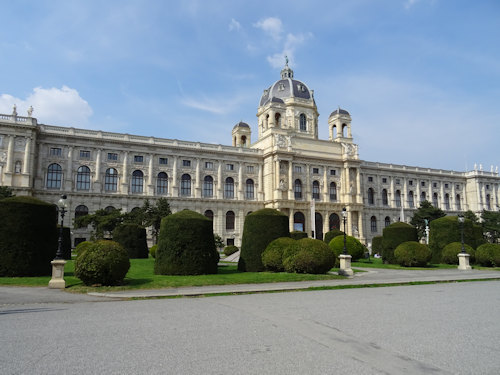Where meteorites meet mammoths and molluscs. Vienna’s Natural History Museum (the Naturhistorisches Museum or NHM) has them all, displayed in one of the city’s most beautiful buildings.
- Extensive collections: minerals, dinosaurs, prehistory, animals, and much more
- Did I mention dinosaurs?
- Home to the ca. 29,000 year-old Venus of Willendorf statue
- Lovely mix of historical setting and modern interactive displays
- What special exhibitions are on?
- Use the Vienna Pass for one-time free entry
- See also:
- Selected past exhibitions at the NHM
- Vienna with children
- Other museums in the city
Inside the NHM

(The NHM as seen from Maria-Theresien-Platz)
Natural history museums can go two ways.
If you’re unlucky, you get dusty cabinets filled with stuffed animals that look like something out of Ebeneezer Wormwood’s World of The Weird and Strange.
If you’re lucky, you get an engaging, fun, and informative peek into the wonders and mysteries of nature.
Fortunately, Vienna’s Naturhistorisches Museum (NHM) leans toward the second variety, even though the collections began life almost three centuries ago.
When you reach the location on Maria-Theresien-Platz, you find two identical-looking buildings on either side of a large square. The one with the elephant statue in front of it is the Naturhistorisches Museum, completed in 1889.
(The building opposite is Vienna’s Kunsthistorisches Museum. If you go in there by mistake, animals will be tricky to find. Though the Four Rivers of Paradise by Peter Paul Rubens features a rather angry-looking tiger and a startled crocodile.)

(Part of the interior architecture; press photo © NHM Wien, Kurt Kracher)
Get some quick visitor information on this page, then dive deeper for further details:
- The geology, dinosaurs & prehistory floor (home to, for example, the illustrious Venus, a remarkable bouquet of flowers, and an animatronic Allosaurus dinosaur)
- The zoological floor (still using many original cabinets that add a Victorian air to the atmosphere)
- The shop and café (the latter occupies a lovely position beneath the main dome, surrounded by historical interior decoration with a scientific slant to it)
- The galleries for the main special exhibition
For some insight into life away from the public areas, read about my experience on a press trip. And for screen entertainment, note that the museum played starring roles in both the Vienna Blood TV series and the Corsage movie.
Tickets, exhibitions & tips

(Scientific greats like Copernicus immortalised in stone)
Entry is relatively inexpensive for a top museum: at the time of writing, kids were free and adults €18 with various concessions. The Vienna Pass (see my review) gets you in once for free.
Special exhibitions
Current schedule for the main exhibitions:
- It’s Not Just the Ravages of Time (until June 15th, 2025): an exhibition around pests found in museums and the associated impacts of climate change
Some tips:
- An information desk in the entrance atrium has folders in English and a supervised cloakroom on the right, where you can check-in your belongings or use coin-operated lockers
- On the left is the shop. Go up the stairs to the right to start your visit “at the beginning” with the geology collection, or climb the stairs ahead to reach the café and zoological collections. Lifts are available, too, of course.
- Once you enter the museum proper, look up
In fact, wherever you are in the museum, always look up and around, not just at the exhibits.
The Naturhistorisches Museum is full of staircases of the “sweeping” kind, as well as ornate marble archways, stone carvings, oil paintings, and glorious ceilings offering a setting often as impressive as any of the scientific contents.

(More of the interior architecture; press photo © NHM Wien, Kurt Kracher)
- The museum is improving continually, so don’t be shocked to find a section closed off temporarily for refurbishment or redesign
- Both main floors take you from room-to-room following the sides of a rectangle until you get back to where you started. However, don’t forget the more central corridors that connect the two long sides of the rectangle (otherwise you’ll miss some super displays)
- Set aside around half a day for looking round, including a cappuccino and cake to finish. You can go round quicker, of course, but you won’t get nearly as much out of the visit
- As you walk around, you’ll spot the occasional item with a large number on it. That’s one of the Top 100 exhibits. The shop has an accompanying guidebook, or just use the numbers as a hint about where to pay close attention
How to get to the museum
As you wind your way through the main walking routes for tourists in Vienna, you probably bump into the museum anyway. The museum also sits next to subway and tram stations. And the hop-on hop-off services stop outside.
Although the formal address is Burgring 7, the visitor entrance is the front and centre of the long building that faces the adjacent landscaped square.
Subway: A short walk from the Volkstheater station, a stop on both the U2 and U3 subway lines
Tram: Lines 1, D, 71, 46, 49 and 2 all go to the Ring/Volkstheater stop, which is above Volkstheater station
Bus: The 48A also goes to Ring/Volkstheater
Address: Burgring 7, 1010 Vienna | Website
You may need to have consented to YouTube/Vimeo cookies, depending on the implementation, to see the following video(s), otherwise you’ll get an error message:
